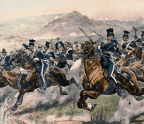

On the strategic level the Battle of Riga, fought in Latvia on Sept. 1–5, 1917, effectively knocked Russia out of World War I. On the tactical level, however, Riga was even more significant. It marked one of the turning points in the history of warfare. The innovative offensive tactics tested by the Germans in that battle proved the key to breaking the long stalemate of trench warfare. After Riga no attack—or at least no successful attack—would ever again be conducted without some variation on those tactics.
It was a lightning offensive. On Sept. 1, 1917, the German Eighth Army, commanded by General of the Infantry Oskar von Hutier, made an assault crossing of the Dvina River (present-day Daugava) some 15 miles east of the city. The Russian Twelfth Army, commanded by General Dmitri Parsky, collapsed in short order. On September 3 German troops marched into the city, and by September 5 little stood between Hutier’s troops and the Russian capital at Petrograd (present-day St. Petersburg), 300 miles to the northeast.
The empire of Tsar Nicholas had been on the verge of collapse ever since Russia’s humiliating defeat in the 1904–05 Russo-Japanese War, and in March 1917 the provisional government of Georgy Lvov (succeeded in July by Alexander Kerensky) finally did replace the 370-year tsarist regime. , the German military command on the Eastern Front, sensed Russia was ripe for the kill. was then under the nominal command of Field Marshal Prince Leopold of Bavaria; but the real command was exercised by his chief of staff, the brilliant Maj. Gen. Max Hoffmann, the General Staff officer who had been the brains behind the German victory at Tannenberg in 1914. Hoffmann resolved to accelerate Russia’s collapse by striking at the old Hanseatic League port of Riga, on a namesake gulf of the Baltic Sea.




